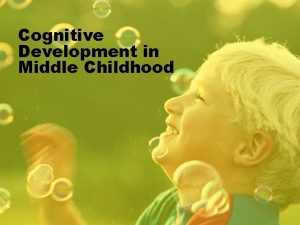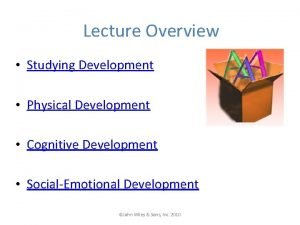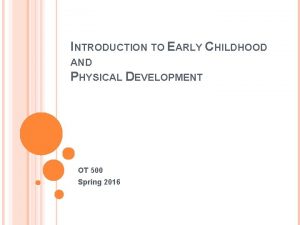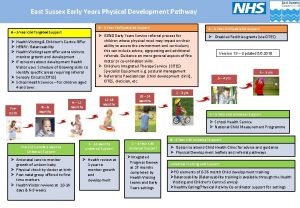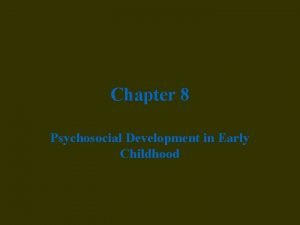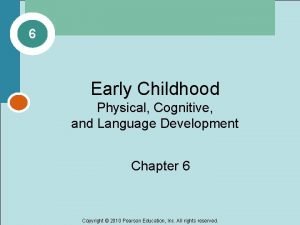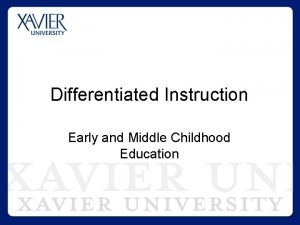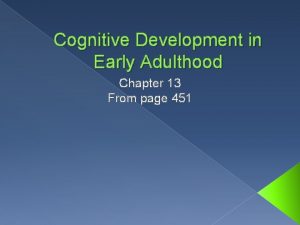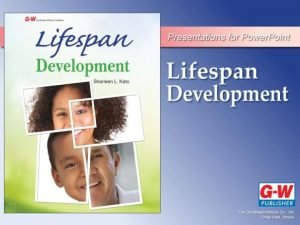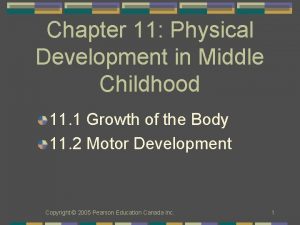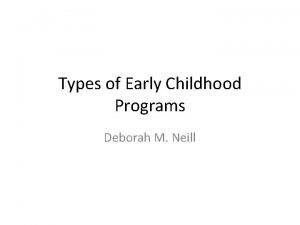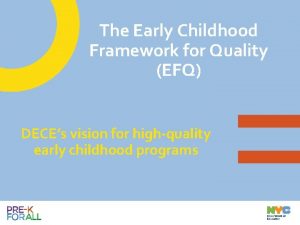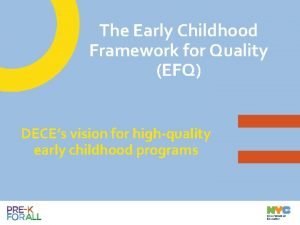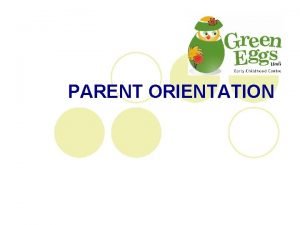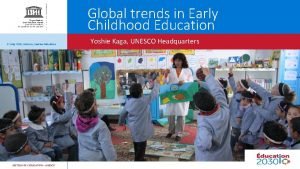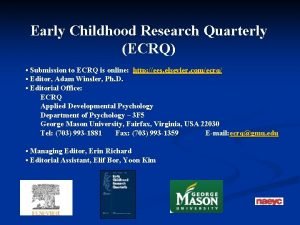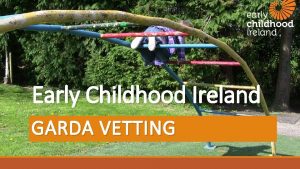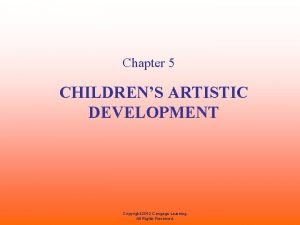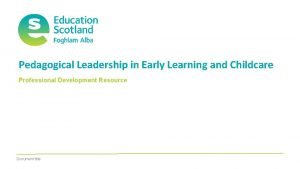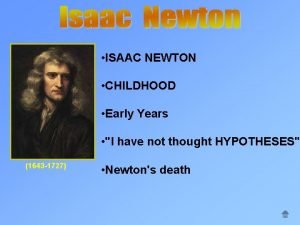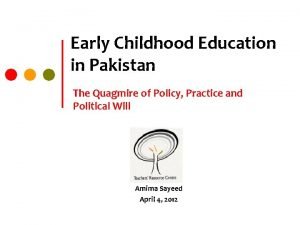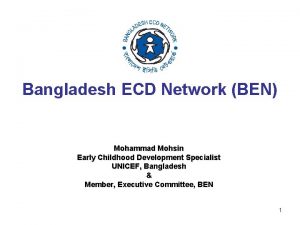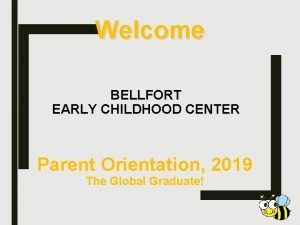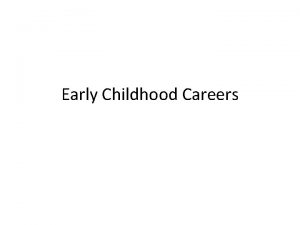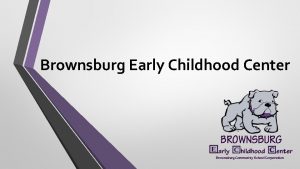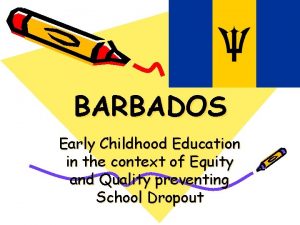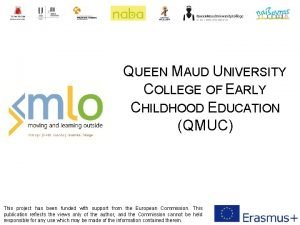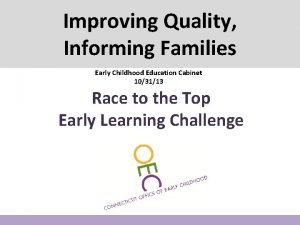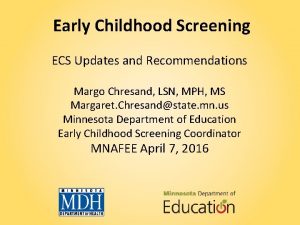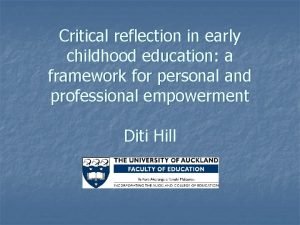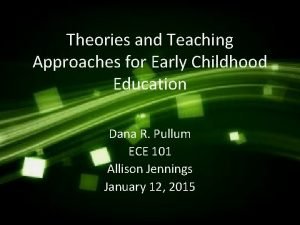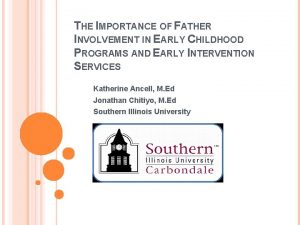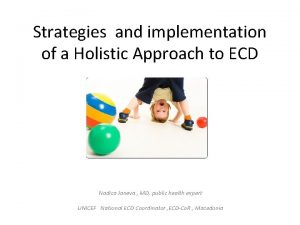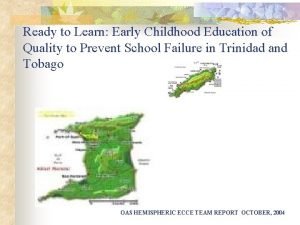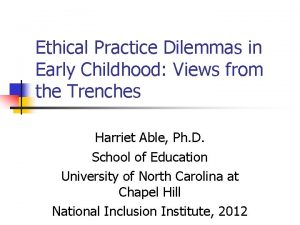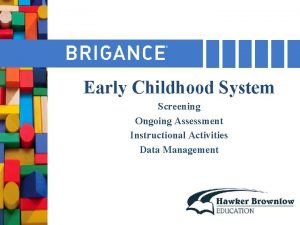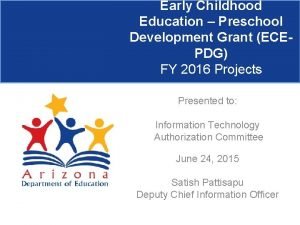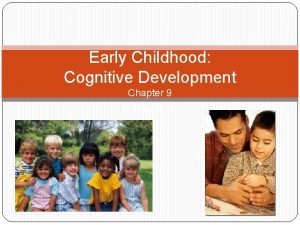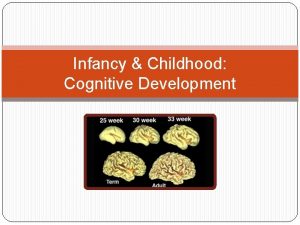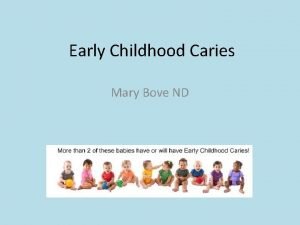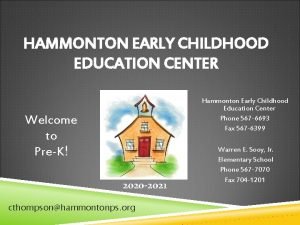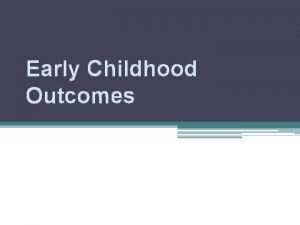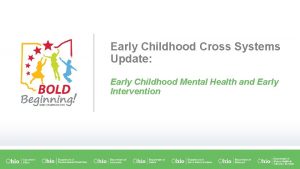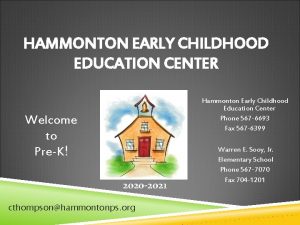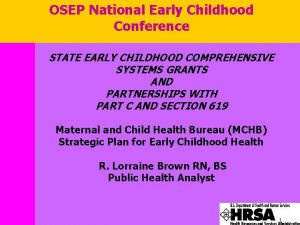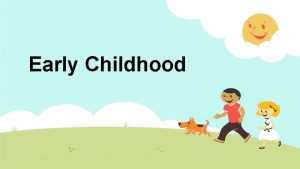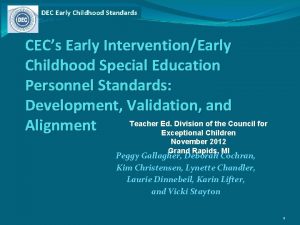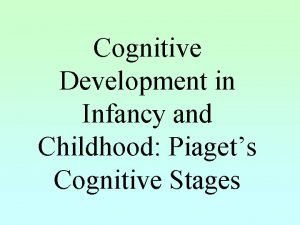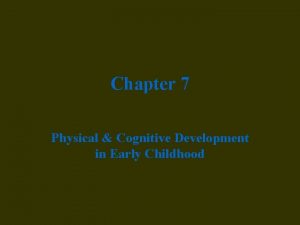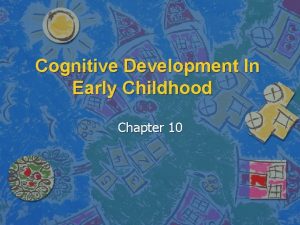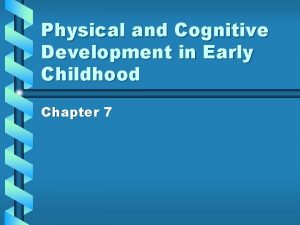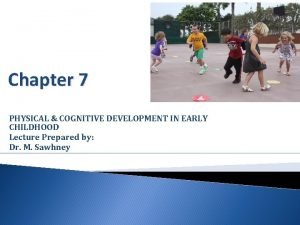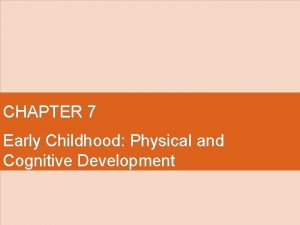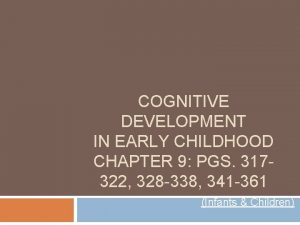Cognitive Development in Early Childhood Chapter 7 from

























































- Slides: 57

Cognitive Development in Early Childhood Chapter 7 (from page 227)

Piaget’s Theory: The Preoperational Stage �Spans 2 -7 years �Most obvious change is an extraordinary increase in representational, or symbolic activity �Mental representation �Language is our most flexible means of mental representation because it detaches thought from action �Piaget believed that sensorimotor activity leads to internal images of experience, which children label with words �But other theorists regard Piaget’s view of the link between language and thought as incomplete

Preoperational Stage: Make-Believe � Through pretending, young children practice and strengthen newly acquired representational schemes � Development of make-believe � Over time, play detaches from the real-life conditions associated with it � In early pretending, toddlers use only realistic objects (ex. A toy telephone to talk into) � First pretend acts imitate adults’ actions and are not yet flexible � After age 2, children pretend with less realistic toys (ex. A block might stand for a telephone receiver) � Gradually, they can flexibly imagine objects and events without any support from the real world � Play becomes less self-centered � At first, make-believe is directed toward the self � Early in the 3 rd year children begin to direct pretend actions toward other objects � Make-believe becomes less self-centered as children realize that agents and recipients of pretend actions can be independent of themselves � Play includes more complex combinations of schemes � Sociodramatic play – the make-believe with others that occurs around age 2 and increases rapidly during the next few years � Creating and coordinating several roles in elaborate plots, by the end of early childhood children have a sophisticated understanding of story lines � Children display awareness that make-believe is a representational activity

Preoperational Stage: Make-Believe � Today, Piaget’s view of make-believe as mere practice of representational schemes is regarded as too limited � Play not only reflects but also contributes to children’s cognitive and social skills �Compared with non-pretend activities (ex. Drawing, putting a puzzle together), during sociodramatic play preschoolers’ interactions last longer, show more involvement, draw more children into the activity, and are more cooperative � Benefits of make-believe �Preschoolers who spend more time at sociodramatic play are seen as more socially competent by their teachers �Studies reveal that make-believe strengthens a wide variety of mental abilities � Sustained attention, memory, logical reasoning, language and literacy skills, imagination, creativity, understanding of emotions, and the ability to reflect on one’s own thinking, control one’s own behavior, and take another’s perspective

Preoperational Stage: Symbol-Real. World Relations � To make-believe and to understand other forms of representation, such as photographs, models, and maps, preschoolers must realize that each symbol corresponds to something specific in everyday life � Study � 2. 5 and 3 year olds watched an adult hide a small toy (Little Snoopy) in a scale model of a room and then were asked to retrieve it from the model. � Then, they were asked to find a larger toy (Big Snoopy) hidden in the same place in the larger room that the model represented � Not until age 3 could most children use the model as a guide to find Big Snoopy in the real room � The 2. 5 year olds did not realize that the model could be both a toy room and a symbol of another room � Results indicate that children younger than 3 have problems with dual representation � Dual representation – viewing a symbolic object as both an object in its own right and a symbol � Experiences with diverse symbols (photos, picture books, make- believe, and maps) help preschoolers appreciate dual representation of symbolic objects, that one object can stand for

Limitations of Preoperational Thought �Aside from gains in representation, Piaget described preschoolers in terms of what they cannot understand �As the term preoperational suggests, Piaget compared children in the stage to older, more competent children who have reached the concrete operational stage �According to Piaget, young children are not capable of operations �Operations – mental actions that obey logical rules �Rather, preoperational children’s thinking is rigid, limited to one aspect of a situation at a time, and strongly influenced by the way things appear at the

Limitations of Preoperational Thought: Egocentrism � Egocentrism – failure to distinguish the symbolic viewpoints of others from one’s own �Piaget believed this was the most fundamental deficiency of preoperational thinking �He believed that when children first mentally represent the world, they tend to focus on their own viewpoint and assume others perceive, think, and feel the same way they do � Ex. 3 -mountains problem �Children in the preoperational stage cannot select a picture that shows the mountains from the doll’s perspective from the other side of the table

Limitations of Preoperational Thought: Egocentrism �Egocentrism is responsible for preoperational children’s animistic thinking �Animistic thinking – the belief that inanimate objects have lifelike qualities, such as thoughts, wishes, feelings, and intentions �According to Piaget, because young children egocentrically assign human purposes to physical events, magical thinking is common during the preschool years �Piaget argued that preschoolers’ egocentric bias prevents them from accommodating, or reflecting on and revising their faulty reasoning in response to their physical and social worlds

Limitations of Preoperational Thought: Inability to Conserve � Piaget’s famous conservation tasks reveal a variety of deficiencies of preoperational thinking � Conservation – the idea that certain physical characteristics of objects remain he same, even when their outward appearance changes �Ex. A boy and girl get identical boxes of raisins at snack time, but when the girl spreads hers out over the table, the boy is convinced she has more � Liquid conservation task �The child is shown 2 identical tall glasses of water and asked if they contain equal amounts �When the child agrees, the water in one class is poured into a short, wide container, changing its appearance but not its amount �Child is then asked whether or not the amount of water has changed �Preoperational children think the quantity has changed �They explain “There is less now because the water is way down here” or “There is more now because it is all spread out”

Limitations of Preoperational Thought: Inability to Conserve �The inability to conserve highlights several related aspects of preoperational thinking �Understanding is centered �Centration – children focus on one aspect of a situation, neglecting other important features �In conservation of liquid, the child centers on the height of the water, failing to realize that changes in width compensate for changes in height �Children are easily distracted by the perceptual appearance of objects �Children treat the initial and final states of the water as unrelated events, ignoring the dynamic transformation (pouring of water) between them

Limitations of Preoperational Thought: Inability to Conserve �Most important illogical feature of preoperational thought is its irreversibility �Irreversibility – inability to mentally go through a series of steps in a problem and then reverse direction, returning to the starting point �Ex. After the girl from the previous example spreads her raisins out, the boy cannot reverse his thinking to say “I know she doesn’t have more raisins than I do because if we put them back in the box, her raisins and my raisins look the same. ”

Limitations of Preoperational Thought: Lack of Hierarchical Classification �Hierarchical classification – the organization of objects into classes and subclasses on the basis of similarities and differences �Piaget’s famous class inclusion problem �Children are shown 16 flowers, 4 blue and 12 yellow �Asked “Are there more yellow flowers or flowers? ” �Preoperational children respond “More yellow flowers. ” �They fail to realize that both yellow and blue flowers are included in the category “flowers. ”

Follow-Up Research on Preoperational Thought �Researchers have challenged Piaget’s view of preschoolers as cognitively deficient �Many Piagetian problems contain unfamiliar elements or too many pieces of information for young children to handle at once, thus their responses do not reflect their true abilities �Piaget also missed many naturally occurring instances of effective reasoning by preschoolers

Follow-Up Research: Egocentric Thinking �Do young children really believe that a person standing across a room sees the same thing they see? �When researchers adapt the 3 -mountains problem to include familiar objects and use methods other than picture selection (which is difficult even for 10 year olds), 4 year olds show clear awareness of others’ vantage points �Even 2 year olds realize that what they see sometimes differs from what another person sees �When asked to help an adult looking for a lost object, 24 month olds, but not 18 month olds, handed her a toy hidden behind a bucket that was within the child’s

Follow-Up Research: Egocentric Thinking �Non-egocentric responses appear in young children’s conversations �Preschoolers adapt their speech to fit the needs of their listeners � 4 year olds use shorter, simpler expression when talking to 2 year olds than to age-mates or adults �Non-egocentric responses in description of objects �Children do not use words such as “big” and “little” in a rigid, egocentric fashion �Rather, they adjust their descriptions to allow for context �By age 3 children judge a 2 inch show as small when seen by itself �But, judge the shoe as big for a tiny 5 inch doll

Follow-Up Research: Animistic Thinking �Piaget overestimated preschoolers’ animistic beliefs �Even young infants have begun to distinguish animate from inanimate �By age 2. 5, children give psychological explanations (“he likes to”) for people and occasionally for animals, but rarely for objects �They do make errors when questioned about vehicles, which appear to be self-moving and have other lifelike features (ex. Headlights that look like eyes) �But these responses result from incomplete knowledge, not from a belief that inanimate objects are alive

Follow-Up Research: Magical Thinking � Most 3 year olds believe in the supernatural powers of fairies, goblins, and other enchanted creatures � They think that magic accounts for events they cannot explain � Older 3 year olds and 4 year olds think that violations of physical laws (walking through a wall) and mental laws (turning the TV on just by thinking about it) require magic more than violations of social conventions (taking a bath with shoes on) � These responses indicate that preschoolers’ notions of magic are flexible and appropriate � Between ages 4 and 8, as children gain familiarity with physical events and principles, their magical beliefs

Follow-Up Research: Illogical Thought � Many studies show that when preschoolers are given tasks that are simplified and relevant to their everyday lives, they do not display the illogical characteristics that Piaget saw in the preoperational stage � Ex. When a conservation of number task is scaled down to include only 3 items instead of 6 or 7, 3 year olds perform well � Preschoolers’ possess impressive ability to engage in reasoning by analogy about physical changes � Presented with the picture-matching problem: “Play-dough is to cut- up play-dough as apple is to…” � Even 3 year olds choose the correct answer (a cut-up apple) from a set of alternatives, several of which share physical features with the right choice � This indicates that in familiar contexts, preschoolers can overcome appearances and think logically about cause and effect � Preschoolers seem to use illogical reasoning only when struggling with unfamiliar topics, too much information, or contradictory facts that they cannot reconcile

Follow-Up Research: Categorization � Although preschoolers have difficulty with Piagetian class inclusion tasks, they organize their everyday knowledge into nested categories at an early age � By 2 nd half of 1 st year, children have formed a variety of global categories (furniture, animals, vehicles, plants, etc), each including objects varying in perceptual features � Objects go together because of their common function or behavior �Challenging Piaget’s assumption that preschoolers’ thinking is governed only by appearances � 2 to 5 year olds readily draw inferences about nonobservable characteristics shared by category members �Ex. After being told that a bird has warm blood and that a stegosaurus has cold blood, preschoolers infer that a pterodactyl has cold blood, even though it closely resembles a bird

Follow-Up Research: Categorization � During 2 nd and 3 rd years children’s global categories differentiate �They form many basic-level categories (ones at an intermediate level of generality � Ex. “chairs, ” “tables, ” and “beds” � By 3 rd year children easily move back and forth between basic-level categories and general categories (ex. “furniture”) and they break down basic-level categories into subcategories �Ex. “rocking chairs” and “desk chairs” � Categorizing skills are supported by their rapidly expanding vocabularies �As they learn more about the world, they devise ideas about underlying characteristics that category members share �Ex. That a combination of physical features, internal organs, and behaviors determine an animal’s identity � Adults also support categorizing by labeling and explaining

Follow-Up Research: Categorization �To sum up �Preschoolers’ category systems are not yet very complex, but they already have the capacity to classify hierarchically and on the basis of nonobvious properties �Preschoolers use logical, causal reasoning to identify the interrelated features that form the basis of a category and to classify new category members

Follow-Up Research: Appearance vs. Reality � What happens when preschoolers encounter objects that have 2 identities (a real one and an apparent one)? � Series of studies presented children with objects that were disguised in various ways and asked what each “looks like” and what each “is really and truly. ” �Ex. Shown a candle that looks like a crayon �Preschoolers had difficulty, not until age 6 or 7 did children do well on these tasks � Younger children’s poor performance is not due to a general difficulty in distinguishing appearance from reality as Piaget suggested � Rather, they have trouble with the language of the tasks �When permitted to solve appearance-reality problems nonverbally, by choosing from a selection of objects the one that “really” has a particular identity, most 3 year olds perform well � This appearance-reality distinction involved an understanding of dual representation

Evaluation of the Preoperational Stage � When given simplified tasks based on familiar experiences, preschoolers show the beginnings of logical thinking, suggesting that Piaget was partly right and partly wrong about their cognitive capacities � Researchers vary on the question of whether Piaget’s preoperational stage actually exists �Evidence that children develop operational thought gradually undermines Piaget’s stage theory, which assumes an abrupt change toward logical reasoning occurs around age 6 or 7 � Some neo-Piagetian theorists combine Piaget’s stage approach with information processing’s emphasis on task specific change, and believe that a related set of competencies develops over an extended time period

Piaget and Education � 3 educational principles derived from Piaget’s theory continue to have a major influence on teacher training and classroom practices, especially in early childhood: �Discovery learning � In a Piagetian classroom, children are encouraged to discover for themselves through spontaneous interaction with the environment �Sensitivity to children’s readiness to learn � Teachers introduce activities that build on children’s current thinking, but do not try to speed development by imposing new skills before children indicate readiness �Acceptance of individual differences � Activities are provided for individual children and small groups, not just the whole class � Teachers evaluate educational progress in relation to the child’s previous development, rather than on the basis of normative standards, or average performance of same-aged peers � Biggest problem with Piaget’s theory is his insistence that learning mainly occurs through acting on the environment, and deemphasis of language-based routes to knowledge

Vygotsky’s Sociocultural Theory �Vygotsky’s theory stresses the social context of cognitive development �In which rapid growth of language broadens preschoolers’ participation in dialogues with more knowledgeable individuals in their culture

Private Speech � Piaget referred to children’s utterances to themselves as egocentric speech, reflecting his belief that young children have difficulty taking the perspective of others � Vygotsky disagreed, believing instead that language is the foundation for all higher cognitive processes, and that children speak to themselves for self-guidance � In Vygotsky’s view, as children get older and tasks become easier, their self-directed speech is internalized as silent, inner speech �The internal verbal dialogues we carry on while thinking and acting in everyday situations � Almost all studies over the past three decades have supported Vygotsky’s perspective �Children’s self-directed speech is now called private speech

Social Origins of Early Childhood Cognition � Vygotsky believed that learning occurs within the zone of proximal development (a range of tasks too difficult for the child to do alone, but possible with the help of adults or more skilled peers) � For learning to be effective, the adult must engage in scaffolding �Scaffolding – adjusting the support offered to fit the child’s current level of performance �Ex. If child is unsure of how to proceed in a task, adult would provide direct instruction. As the child’s competence increases adult gradually withdraws support and turns responsibility over to the child � Children gradually take the language of their dialogues with adults and make it part of their private speech,

Vygotsky and Education � Both Vygotskian and Piagetian classrooms emphasize independent discovery and acceptance of individual differences �But Vygotskian classrooms also promote assisted discovery �Teachers guide children’s learning tailoring their interventions to each child’s zone of proximal development �Assisted discovery is also aided by peer collaboration as children of varying abilities work in groups, teaching and helping one another � Vygotsky saw make-believe play as the ideal social context for fostering cognitive development �As children create imaginary situations, they learn to follow internal ideas and social rules rather than their immediate impulses �Ex. A child pretending to go to sleep follows the rules of bedtime behavior and a child pretending to be his father

Evaluation of Vygotsky’s Theory � One challenge to Vygotsky’s theory suggests that verbal communication is not the only means through which children’s thinking develops �Or in some cultures, even the most important means �In cultures that place less emphasis on schooling and literacy, parents often expect children to take greater responsibility for acquiring new skills through observation and participation in group activities � To account for children’s diverse ways of learning through involvement with others, Barbara Rogoff suggests the term guided participation �Guided participation – broader concept than scaffolding, referring to shared endeavors between more expert and less expert participants, without specifying the precise features of communication � Vygotsky’s theory says little about how basic motor, perceptual, attention, memory, and problem-solving skills contribute to socially transmitted higher cognitive processes �An area Piaget paid more attention to

Information Processing �Information processing focuses on mental strategies that children use to transform stimuli flowing into their mental systems �During early childhood, advances in representation and in the ability to guide one’s own behavior lead to more efficient ways of attending, manipulating information, and solving problems �Preschoolers also become more aware of their own mental life and begin to acquire academically relevant knowledge important to school success

Information Processing: Attention � Compared to school-age children, preschoolers spend shorter times involved in tasks and are easily distracted � Inhibition �Attention improves in toddlerhood and beyond as children steadily gain in their ability to inhibit impulses and remain focused on a goal �In Tools of the Mind (an effective preschool curriculum inspired by Vygotsky’s theory) scaffolding of attentional skills is woven into virtually all classroom activities �Ex. Teachers provide external aids to support attention � A child might hold a drawing of an ear as a reminder to listen during story time �Ex. Teachers lead games requiring frequent shifts in attention and encourage make-believe play, which helps children follow rules and use thought to guide behavior � Planning �During early childhood, children also become better at planning � Planning – thinking out a sequence of acts ahead of time and allocating attention accordingly to reach a goal

Information Processing: Recognition and Recall Memory � Preschoolers’ recognition memory is remarkably good � Recognition – ability to tell whether a stimulus is the same or similar to one they have seen before � Ex. Show child a set of 10 pictures or toys, then mix them up with some unfamiliar items and ask the child to point to the ones in the original set � 4 -5 year olds perform nearly perfectly � But recall is much poorer � Recall is more demanding because it requires the child to generate a mental image of an absent stimulus � Ex. Show child set of 10 pictures, remove them from view and ask the child to name the pictures they saw � 2 year olds can only recall around 1 or 2 of the items � 4 year olds can only remember about 3 or 4 � Why? � Because preschoolers are not yet skilled at using memory strategies – deliberate mental activities that improve the chances of remembering � Ex. Rehearsal (repeating items over and over to remember) and organization (grouping items together that are alike)

Information Processing: Memory for Everyday Experiences � Memory for familiar events � Like adults, preschoolers remember familiar events in terms of scripts � Scripts – general descriptions of what occurs and when it occurs in a particular situation � Memory for unfamiliar events � Autobiographical memory – representations of personally meaningful, one-time events � Reflects improvements in preschoolers’ cognitive and conversational skills � Parents who use the elaborative style to elicit children’s autobiographical memory follow the child’s lead, ask varied questions, add information to the child’s statements, and volunteer their own recollections and evaluations of events � Ex. “What was the first thing we did on our trip to the zoo? ” “Why weren’t the parrots in their cages? ” “I thought the lion was scary, what did you think? ” � Parents who use the repetitive style provide little information and keep repeating the same questions, regardless of the child’s interest � Ex. “Do you remember the zoo? ” What did we do at the zoo? ” � Preschoolers who experience the elaborative style recall more information and also produce more organized and detailed personal stories when followed up 1 -2 years later

The Young Child’s Theory of Mind � As representation of the world, memory, and problem solving improve, children start to reflect on their own thought processes and begin to construct a theory of mind �Theory of mind – coherent set of ideas about mental activities � Also called metacognition – “thinking about thought” � Awareness of mental life �By the end of the 1 st year, babies view people as intentional beings �By age 2, they have a clearer grasp of others’ emotions and desires, evident in their realization that people often differ from one another and from themselves in likes, dislikes, wants, needs, and wishes �By age 3, children realize that thinking takes place inside their head and that a person can think about something without seeing, touching, or talking about it �From age 4 on, children realize that both beliefs and desires determine behavior � Seen in their ability to recognize that people’s actions may be guided by false beliefs � False beliefs – beliefs that do not accurately represent reality

Factors Contributing to Preschoolers’ Theory of Mind � Language, cognitive abilities, make-believe play, and social experiences all contribute to theory of mind � Many studies indicate that language ability strongly predicts preschoolers’ grasp of false-belief tasks � Children who spontaneously use, or who are trained to use, complex sentences with mental-state words are especially likely to pass false-belief tasks � Gains in the ability to inhibit inappropriate responses, think flexibly, and plan are strongly related to mastery of false-belief tasks � Social experience also promotes understanding of the mind � Maternal “mind-mindedness, ” when mothers appropriately comment on their infant’s mental states (ex. “do you remember grandma? ” “you really like that swing!”), relates positively with later performance on false-belief tasks � Core knowledge theorists believe that children are biologically prepared to develop a theory of mind � They claim that children with autism are deficient in the brain mechanism that enables humans to detect mental states and form a theory of mind

Limitations of Preschoolers’ Understanding of Mental Life � Although surprisingly advanced, preschoolers awareness of mental activities is far from complete � 3 -4 year olds are unaware that people continue to think when there are no obvious cues that they are thinking �Children younger than 6 pay little attention to the process of thinking � When asked about subtle distinctions between mental states, such as know and forget, they express confusion �They believe that all events must be directly observed to be known and do not understand that mental inferences can be a source of knowledge � This suggests that preschoolers view the mind as a passive container of information �Consequently, they greatly underestimate the amount of mental activity that people engage in and are poor at inferring what people know or are thinking about

Early Childhood Literacy � Preschoolers understand quite a bit about written language long before they learn to read or write in conventional ways � Through informal experiences, such as listening to a parent read a story book or trying to help make a shopping list, children actively try to figure out how written symbols convey meaning, a process known as emergent literacy �Emergent literacy – children’s active efforts to construct literacy knowledge through informal experiences �Preschoolers search for units of written language as they “read” memorized versions of stories and recognize familiar signs (ex. “PIZZA”) � But they do not yet understand the symbolic function of the elements of print

Early Childhood Literacy � Eventually, children figure out that letters are parts of words and are linked to sounds in systematic ways � Evident in the invented spellings that are typical between ages 5 -7 � At first, children rely on sounds in the names of letters � Ex. “ADE LAFWTS KRMD NTU A LAVATR” (“eighty elephants crammed into a[n] elevator”) � Phonological awareness – the ability to reflect on and manipulate the sound structure of spoken language � Indicated by sensitivity to changes in sounds within words, to rhyming, and to incorrect pronunciation � Phonological awareness is a strong predictor of emergent literacy knowledge � The more informal literacy-related experiences children have, the better development of their language and emergent literacy skills, as well as later reading skills � Children from low-SES families have fewer home and preschool language and literacy learning opportunities (a major reason that they stay behind in reading achievement throughout the school years) � Interventions which provided books to preschools and homes of low-SES children and trained caregivers on how to get 3 -4 year olds to spend time with books, showed great improvement in emergent literacy

Young Children’s Mathematical Reasoning � Like literacy, mathematical reasoning builds on informally acquired knowledge �Between 14 -16 months, toddlers display a beginning understanding of ordinality �Ordinality – order relationships between quantities �Ex. That 3 is more than 2 and 2 is more than 1 � By age 3 most children can count rows of about 5 objects, but they do not know exactly what the words mean �Ex. When asked for 1, they give 1 item, but when asked for 2, 3, 4, or 5, they usually give a larger but incorrect amount �However, they do understand that a number word refers to a unique quantity � By age 3. 5 to 4 years, most children master the principle of cardinality �Cardinality – that the last number in a counting sequence indicates the quantity of items in a set

Young Children’s Mathematical Reasoning � Around age 4 children use counting to solve arithmetic problems � At first, their strategies are tied to the order of numbers presented �Ex. To add 2 + 4, they count up from 2 � But soon they experiment with other strategies and arrive at the most efficient approach �Ex. To add 2 + 4, they would begin counting up from 4 � Around this time children realize that subtraction cancels out addition �Ex. Knowing that 4 + 3 = 7, they can infer without counting that 7 – 3=4 � Grasping basic arithmetic rules facilitates rapid computation and with enough practice children recall answers automatically � When adults provide many occasions for counting,

Individual Differences in Mental Development � Mental tests for preschoolers sample a range of verbal and nonverbal cognitive abilities � Verbal � Vocabulary – showing child a picture and asking them what is in the picture � Memory – asking children to repeat sentences and lists of numbers � Nonverbal � Spatial reasoning – asking child to copy designs with special blocks, figure out the pattern in a series of shapes, and indicate what a piece of paper folded and cut would look like when unfolded � Intelligences tests do not sample all human abilities, and performance is affected by cultural and situational factors � Low-SES and certain ethnic minority preschoolers may react with anxiety when bombarded with questions by an unfamiliar adult � Such children may not define the testing situation in achievement terms, instead they may look for attention and approval from the adult and may settle for lower performance than their actual abilities � By age 6 -7, mental test scores are good predictors of later IQ and academic achievement, which are related to vocational success in industrialized societies

Home Environment and Mental Development � Preschoolers who develop well intellectually have homes rich in educational toys and books �Parents are warm and affectionate, stimulate language and academic knowledge, and arrange interesting outings �Parents also resolve conflicts with reason instead of physical force and punishment � Ex. Parents require the child to perform simple chores and behave courteously toward others � These characteristics are seen less often in poverty- stricken families �But, when low-SES parents manage, despite daily pressures, to obtain a positive and stimulating home environment, their preschoolers do substantially better on tests of intelligence and emergent literacy skills � Home environment plays a major role in the generally poorer intellectual performance of low-SES children in comparison to their higher-SES peers

Preschool, Kindergarten, and Child Care �Largely because of the rise in maternal employment, over 60% of young children in the U. S. are enrolled in preschool or child care �A preschool – is a program with planned educational experiences aimed at enhancing development in 2 -5 year olds �Child care describes a variety of arrangements for supervising children �Good child care should do more than simply keep children safe and adequately fed, it should provide the same high-quality educational experiences as an effective preschool

Types of Preschool and Kindergarten � Preschool and kindergarten programs range along a continuum from child-centered to teacher-directed � Child-centered programs – teachers provide a wide variety of activities from which children select, and much learning occurs through play � Academic programs (teacher directed) – teachers structure children’s learning, teaching letters, numbers, colors, shapes, and other academic skills through formal lessons, often using repetition and drill � Despite evidence that formal academic training in early childhood undermines motivation and emotional well-being, preschool and kindergarten teachers have felt increased pressure to take this approach � Montessori education � Special type of child-centered education � Schooling includes materials designed to promote exploration and discovery, child-chosen activities, and equal emphasis on academic and social development � Research has indicated that children who completed 2 years of Montessori education perform better in literacy and math skills, false-

Early Intervention for At-Risk Preschoolers � Project Head Start – a long-standing U. S. program that provides low-SES children with a year or two of preschool education � Parent involvement is central to the Head Start philosophy � Parents serve on policy councils, contribute to program planning, work directly with children in classrooms, attend special programs on parenting and child development, and receive services directed at their own emotional, social, and vocational needs � High/Scope Perry Preschool Project – research study on the benefits of preschool � Results revealed lasting benefits into adulthood � 2 years exposure to cognitively enriching preschool was associated with increased employment and reduced pregnancy and delinquency rates in adolescence � At age 27, those who attended preschool were more likely to have graduated from high school and college, have higher earnings, be married, and own their own home, and were also less likely to have been involved with the criminal justice system � Gains from programs such as Head Start typically decline as low-SES children enter inferior public schools in poverty-stricken neighborhoods which undermine the benefits of preschool education � Still, Head Start is highly cost-effective compared with the cost of providing special education, treating criminal behavior, and supporting unemployed adults � Economists estimate a life-time return to society of more than $250, 000 on an investment of $15, 000 per preschool child

Child Care � Preschoolers exposed to poor-quality child care, especially for long hours, score lower on measures of cognitive and social skills and higher in behavior problems �Psychological well-being also declines when children experience the instability of several child-care settings �The emotional problems of temperamentally difficult preschoolers worsen considerably � In contrast, good child care enhances cognitive, language, and social development, especially for low. SES children �In a study that followed very-low-income children over the preschool years, center-based care was more strongly associated with cognitive gains than were other child-care arrangements � Probably because centers are more likely to provide a systematic

Educational Media � Besides home and preschool, young children spend much time in another learning environment: electronic media, including both television and computers (and more recently tablets and handheld gaming devices) � In the U. S. and other industrialized nations �Nearly all homes have at least one television and most have two or more �About 85% of U. S. children live in homes with one or more computers, 2/3 of which have an Internet connection

Educational Television � Time devoted to watching children’s educational programs, such as Sesame Street, is associated with gains in early literacy and math skills and academic progress in elementary school �One study reported a link between preschool viewing of Sesame Street and other similar educational programs and getting higher grades, reading more books, and placing more value on achievement in high school � Viewing children’s programs with slow-paced action and easy-to-follow narratives, such as Barney and Friends, leads to more elaborate make-believe play than viewing programs that present quick, disconnected bits of information � However, whereas educational programs can be beneficial, watching entertainment TV, especially heavy viewing, detracts from children’s school success and

Learning with Computers � Many early childhood classrooms include computer learning centers �Word-processing programs can support emergent literacy � Enables children to experiment with letters and words without having to struggle with handwriting and to easily revise their text and check their spelling � When children worry less about making mistakes, their written products tend to be longer and higher in quality �Simplified computer languages that children can use to make designs or build structures introduce them to programming skills � As long as adults support children’s efforts, computer programming promotes improved problem solving and metacognition because children must plan and reflect on their thinking to get their programs to work � However, children spend much time using computers for entertainment purposes, especially game playing �Both television programming and computer games are filled with gender stereotypes and violence, which can have a

Language Development: Vocabulary � By age 6, a child will have acquired around 10, 000 words � Research shows that children can connect new words with their underlying concepts after only a brief encounter, a process called fast-mapping � Types of words �Children fast-map labels for objects especially rapidly because they refer to concepts that are easy to perceive � Ex. When adults point to, label, and talk about an object they help the child figure out the word’s meaning �Verbs (ex. go, run, broke) are soon added, followed by modifiers (ex. red, round, sad) � Verbs require more complex understanding of relationships between objects and actions �To fill in for words they do not yet know, children as young as 3 coin new words using words they do know, and also extend language meanings through metaphors � Ex. Saying “plant-man” to refer to a gardener � Ex. Describing a stomachache as a “fire engine in my tummy”

Language Development: Vocabulary � Strategies for word learning �In early vocabulary growth, children may adopt a mutual exclusivity bias � Mutual exclusivity bias – assuming that words refer to entirely separate and nonoverlapping categories �According to one proposal, children figure out many word meanings by observing how words are used in the structure of sentences � Ex. An adult who says “This is a citron one” while showing a child a yellow car � 2 -3 year olds conclude that the new word (citron) used as an adjective for the familiar object (car) refers to a property of the object � As they hear the word in various sentence structures (ex. “That lemon is bright citron. ”) they refine its meaning �When parents provide children with clarifying information about word meanings, their preschoolers’ vocabularies grow more rapidly

Language Development: Vocabulary � Explaining Vocabulary Development �Some theorists believe children are innately biased to induce word meanings using certain principles, such as mutual exclusivity � But, critics point out that a small set of built-in principles cannot account for the varied, flexible way in which children master vocabulary � And, many word-learning strategies cannot be innate because children acquiring different languages use different approaches to master the same meanings �An alternative view is that children gain vocabulary by using the same cognitive strategies they apply to nonlinguistic information � Children may use a combination of cues (perceptual, social, and linguistic), which shift in importance with age � Infants rely solely on perceptual features � Toddlers and young preschoolers increasingly attend to social cues (ex. Speaker’s direction of gaze, gestures, and expressions) � As language develops further, linguistic cues, such as sentence

Language Development: Grammar � Between ages 2 -3, children adopt the word orders of the adult speech to which they are exposed � Ex. English-speaking children use simple sentences that follow a subject-verb-object word order � Basic rules � Children first use of grammatical rules is bit by bit, limited to just a few verbs � As children listen for familiar verbs in adults’ speech, they expand their own utterances containing those verbs, relying on adult speech as a model � Ex. A child adds the preposition “with” to the verb “open”: “You open with scissors, ” but not to the word “hit”: “He hit me stick” � Once children can form 3 -word sentences, they make small additions and changes to words (grammatical markers) that enable them to express meanings flexibly and efficiently � Ex. Adding –s for plurals “cats, ” use prepositions “in” and “on, ” and form various tenses of the verb “to be” (“is, ” “are, ” “were, ” “has been, ” “will”) � All English-speaking children master grammatical markers in a regular sequence � Starting with those that involve the simplest meanings and structures � Once children acquire these markers they sometimes overextend the rules to words that are exceptions, called overregularization � Ex. “My toy car breaked” and “We each have two feets. ”

Language Development: Grammar � Complex structures �Gradually, preschoolers master more complex grammatical structures, although they do make mistakes � In first creating questions, 2 -3 year olds use many formulas: “Where’s X? ” or “Can I X? ” �Children have trouble with passive sentences, but by age 5 they usually come to understand these expressions � Ex. When told “The car was pushed by the truck, ” young preschoolers often make a toy car push a truck �By age 4 -5, children form embedded sentences (ex. “I think he will come”), tag questions (“ Dad’s going to be home soon, isn’t he? ”), and refer to indirect objects/people (“He showed his friend the present”) �By age 4 -5, children use most of the grammatical constructions of their language competently

Language Development: Grammar � Explaining grammatical development �Information-processing theorists believe that grammar is a product of general cognitive development � Suggest children’s tendency to search for consistencies and patterns of all sorts leads them to notice which words appear in the same positions in sentences and are similarly combined with other words � Over time, they group words into grammatical categories and use them appropriately in sentences �Other theorists believe that children are specially tuned to acquire grammar � One idea proposes that the grammatical categories into which children group word meanings are innate �In another view, rather than starting with innate knowledge, children have built-in procedures for analyzing language that support discovery of grammatical regularities � Controversy still persists over whether a universal language-processing device exists or whether children hearing different languages devise unique strategies

Language Development: Conversation � Pragmatics – the practical, social side of language �This is how children learn to engage in effective communication with others � By age 2, children are skilled conversationalists �In face-to-face interaction they take turns and respond appropriately to their partners’ remarks �With age, the number of turns over which children can sustain interaction and their ability to maintain a topic over time increase � By age 4, children adjust their speech to fit the age, sex, and social status of their listeners �Ex. In acting out roles with hand puppets, they use more commands when playing socially dominant and male roles (teacher, doctor, father) and speak more politely and use more indirect requests when playing less dominant and female roles (student, patient, mother)

Supporting Language Development in Early Childhood � Conversational give-and-take with adults is consistently related to language progress � Additionally, adults can use other techniques to promote early language skills � When children use words incorrectly or communicate unclearly, adults can give helpful, explicit feedback � Ex. “I can’t tell which ball you want. Do you mean the large red one? ” � But, adults must be careful not to overcorrect, especially when children make grammatical mistakes � Criticism discourages children from freely using language in ways that lead to new skills � Adults often provide indirect feedback about grammar by using recasts and expansions � Recasts – restructuring inaccurate speech into correct form � Expansions – elaborating on children’s speech, increasing its complexity � Ex. If a child says “I gotted new shoes. ” the parent might say “Yes, you got a pair of new red shoes. ”
 Early childhood is __________ for language learning
Early childhood is __________ for language learning Middle and late childhood
Middle and late childhood Middle and late childhood
Middle and late childhood Module 47 infancy and childhood cognitive development
Module 47 infancy and childhood cognitive development Language development in middle childhood
Language development in middle childhood Three prenatal stages
Three prenatal stages Module 47 infancy and childhood cognitive development
Module 47 infancy and childhood cognitive development Fine motor skills development in early childhood
Fine motor skills development in early childhood Physical development in early childhood
Physical development in early childhood Psychosocial development in early childhood
Psychosocial development in early childhood Language development in early childhood
Language development in early childhood Biosocial development in early childhood
Biosocial development in early childhood Ldoe delivery recipes
Ldoe delivery recipes Early adulthood cognitive development
Early adulthood cognitive development Labouvie-vief pragmatic thought
Labouvie-vief pragmatic thought Cognitive changes in early adulthood
Cognitive changes in early adulthood Types of early childhood programs activity a chapter 2
Types of early childhood programs activity a chapter 2 Chapter 7 early childhood ages 3 through 5
Chapter 7 early childhood ages 3 through 5 Cognitive and non cognitive religious language
Cognitive and non cognitive religious language Physical development in middle childhood chapter 11
Physical development in middle childhood chapter 11 Chapter 5 cognitive development in infancy and toddlerhood
Chapter 5 cognitive development in infancy and toddlerhood Three types of early childhood programs
Three types of early childhood programs E f q
E f q Early childhood framework for quality
Early childhood framework for quality Ecetp.pdp.albany.edu.elearning
Ecetp.pdp.albany.edu.elearning Green eggs early childhood centre
Green eggs early childhood centre Acecqa self assessment tool
Acecqa self assessment tool Leonardo da vinci early childhood
Leonardo da vinci early childhood Trends in early childhood education
Trends in early childhood education Early childhood research quarterly impact factor
Early childhood research quarterly impact factor Garda vetting form early childhood ireland
Garda vetting form early childhood ireland Kellogg's stages of artistic development
Kellogg's stages of artistic development Amelia earhart characteristics
Amelia earhart characteristics Prosposed
Prosposed Pedagogical leadership style
Pedagogical leadership style Newton childhood
Newton childhood Eminem early childhood
Eminem early childhood Early childhood education in pakistan
Early childhood education in pakistan Early childhood education in bangladesh
Early childhood education in bangladesh Bellfort early childhood center
Bellfort early childhood center Associates in early childhood education jobs
Associates in early childhood education jobs Becc brownsburg
Becc brownsburg Early childhood education barbados
Early childhood education barbados Early childhood education
Early childhood education Kentucky governor's office of early childhood
Kentucky governor's office of early childhood Connecticut early childhood education cabinet
Connecticut early childhood education cabinet Minneapolis preschool screening instrument-revised (mpsi-r)
Minneapolis preschool screening instrument-revised (mpsi-r) Smyth reflection
Smyth reflection Artistic talents of rizal
Artistic talents of rizal Early childhood center flushing mi
Early childhood center flushing mi Skinner's theory
Skinner's theory Father involvement activities
Father involvement activities Holistic approach in early childhood education
Holistic approach in early childhood education Swot analysis early childhood education
Swot analysis early childhood education Cosf examples
Cosf examples Ethical dilemmas in early childhood education
Ethical dilemmas in early childhood education Ongoing assessment early childhood
Ongoing assessment early childhood Early childhood education
Early childhood education




